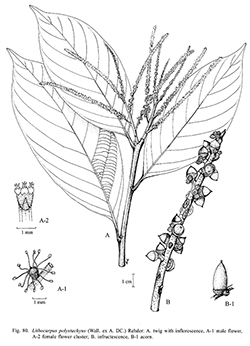e-Flora of Thailand
Volume 9 > Part 3 > Year 2008 > Page 319 > Fagaceae > Lithocarpus
39. Lithocarpus polystachyus (Wall. ex A.DC.) Rehderwfo-0000230171
J. Arnold Arbor. 1: 130. 1919; Barnett, Quer. Rel. Fag. Asia: 105. 1940; Trans. & Proc. Bot. Soc. Edinburgh 33.3: 333. 1941; l.c. 34: 333. 1944; Hjelmq., Dansk Bot. Ark., 23.4: 487, 1968.— Quercus polystachya Wall. ex A.DC., Prodr. (DC.) 16.2: 107. 1864; Kurz, Forest Fl. Burma 2: 485. 1877; King ex Hook.f., Fl. Brit. Ind. 5: 610. 1888; Craib, Bull. Misc. Inform. Kew 1911: 472. 1911; Brandis, Indian Trees: 630. 1921.— Pasania polystachya (Wall. ex A.DC.) Schottky, Bot. Jahrb. Syst. 47: 667. 1912.— Synaedrys polystachya (Wall. ex A.DC.) Koidz., Bot. Mag. (Tokyo) 30: 197. 1916. Fig. 80.
Accepted Name : This is currently accepted.
Synonyms & Citations :
Description : Tree, 5–20 m high, 45–100 cm girth. Twigs grey pubescent then glabrescent. Bark dark grey to brown, deeply furrowed, 2–3 cm thick; inner bark dark brown; sapwood brownish. Leaves oblong, ovate-lanceolate or elliptic, 9–23 by 3–8 cm; base obtuse, slightly cuneate; apex acute, acuminate to caudate; margins entire; coriaceous or subcoriaceous, glabrous, glossy green on the upper surface, silver green to glaucous on the lower. Young leaves with black and sticky oily coating; midrib and nerves 8–10 pairs, arched but not anastomosing, scalariform veins distinct on the lower surface. Petiole 0.5–2.2 cm, pubescent then glabrescent. Inflorescences male and female separate or female below, spikes or panicles, terminal and axillary, pubescent. Male inflorescence a spike or branched, spikes or spikelets 5–10 cm long; bracts and bracteoles ovate, 2–2.5 by 0.5–1 mm, pubescent outside. Male flowers yellowish white, scented, always solitary; calyx 6-lobed, broadly campanulate, up to 1 mm long, lobes ovate, divided ca ¼ to the base, pubescent outside; stamens 12, 2.5–3 mm long glabrous; rudimentary ovary subglobose, ca 1 mm in diam., hirsute. Female inflorescence spike 10–25 cm long. Female flowers always in (1)–3-flowered cluster, other characters as in male flowers; styles 3, divergent, glabrous; stigmata pointed. Acorns fine, conical, 1.2–2.7 by 0.9–1.2 cm (including cupule); fruit-stalk 1–4 mm long, on erect and slender infructescence 10–30 cm long, the latter 0.4–1 cm in diam., and always with distinct sub-branches; acorns fused or adnate near base (some free); indehiscent. Cupule cup-shaped, enclosing ⅕ to ⅓ of the nut; wall comprising alternate scales with grey indumentum, fused throughout internally, apex more or less free. Nut conical, 1.1–2.6 by 0.7–1.2 cm, glossy brown; scar 0.5–1 mm in diam., at base of nut.
Thailand : NORTHERN: Mae Hong Son, Chiang Mai, Chiang Rai, Lamphun, Lampang, Phitsanulok, Kamphaeng Phet; NORTH-EASTERN: Phetchabun, Loei, Maha Sarakham; EASTERN: Nakhon Rachasima, Ubon Ratchathani; SOUTH-WESTERN: Uthai Thani, Kanchanaburi; CENTRAL: Suphan Buri; SOUTH-EASTERN: Trat; PENINSULAR: Ranong, Narathiwat.
Distribution : India, Burma (type), Laos, Vietnam.
Ecology : Deciduous dipterocarp forests, pine deciduous dipterocarp forests, mixed deciduous forests, old clearings, to lower montane rain forests, on sandstone bedrock, 60–2,200 m (most commonly 600–1,000 m). Flowering: January–December (most commonly November–May); fruiting: June–November (most commonly June–July).
Vernacular : Ko mak (ก่อหมาก), ko hin (ก่อหิน), ko ngae (ก่อแงะ), ko daeng (ก่อแดง), ko ta mu (ก่อตาหมู)(Northern); ko ket dam (ก่อเก็ดดำ)(Northeastern); ko hua mu (ก่อหัวหมู)(Eastern); ko kua (ก่อคั่ว)(Peninsular).
Uses: Nuts edible.

